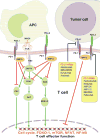Oncogenic Signaling Pathways and Pathway-Based Therapeutic Biomarkers in Lymphoid Malignancies
- PMID: 29604930
- PMCID: PMC5961736
- DOI: 10.1615/CritRevOncog.2017020816
Oncogenic Signaling Pathways and Pathway-Based Therapeutic Biomarkers in Lymphoid Malignancies
Abstract
Lymphoma is characterized by heterogeneous biology, pathologic features, and clinical outcome. This has been proven by accumulating pathologic and molecular evidence attributed to underlying aberrant alterations at genetic, epigenetic, transcriptional, protein, microenvironmental levels, and dysregulated oncogenic signaling pathways. In the era of precision medicine, targeting oncogenic pathways to design drugs and to optimize treatment regimens for the lymphoma patients is feasible and clinically significant. As such, further understanding of the biology and the mechanisms behind lymphoma development and identification of oncogenic pathway activation and pathway-based biomarkers to better design precise therapies are challenging but hopeful. Furthermore, pathway-based targeted therapies in combination with traditional chemotherapy, single specific targeted antibody therapy, and immunotherapy might raise the hope for the patients with lymphoma, especially for relapsed and refractory lymphoma patients.
Figures




Similar articles
-
Critically dysregulated signaling pathways and clinical utility of the pathway biomarkers in lymphoid malignancies.Chronic Dis Transl Med. 2018 Mar 12;4(1):29-44. doi: 10.1016/j.cdtm.2018.02.001. eCollection 2018 Mar. Chronic Dis Transl Med. 2018. PMID: 29756121 Free PMC article. Review.
-
Precision therapy for lymphoma--current state and future directions.Nat Rev Clin Oncol. 2014 Oct;11(10):585-96. doi: 10.1038/nrclinonc.2014.137. Epub 2014 Aug 19. Nat Rev Clin Oncol. 2014. PMID: 25135367 Review.
-
Advances in targeted therapy for malignant lymphoma.Signal Transduct Target Ther. 2020 Mar 6;5(1):15. doi: 10.1038/s41392-020-0113-2. Signal Transduct Target Ther. 2020. PMID: 32296035 Free PMC article. Review.
-
Epigenetic targeting in lymphoma.Br J Haematol. 2021 Jan;192(1):50-61. doi: 10.1111/bjh.16914. Epub 2020 Jul 1. Br J Haematol. 2021. PMID: 32609383 Review.
-
Double hit lymphoma: from biology to therapeutic implications.Expert Rev Hematol. 2016 Jul;9(7):669-78. doi: 10.1080/17474086.2016.1182858. Epub 2016 May 21. Expert Rev Hematol. 2016. PMID: 27166590 Review.
Cited by
-
Zinc is an important inter-kingdom signal between the host and microbe.Vet Res. 2021 Mar 4;52(1):39. doi: 10.1186/s13567-021-00913-1. Vet Res. 2021. PMID: 33663613 Free PMC article. Review.
-
New insights into the biology of T-cell lymphomas.Blood. 2024 Oct 31;144(18):1873-1886. doi: 10.1182/blood.2023021787. Blood. 2024. PMID: 39213420 Review.
-
Advancements in B-Cell Non-Hodgkin's Lymphoma: From Signaling Pathways to Targeted Therapies.Adv Hematol. 2024 Nov 12;2024:5948170. doi: 10.1155/2024/5948170. eCollection 2024. Adv Hematol. 2024. PMID: 39563886 Free PMC article. Review.
References
-
- Swerdlow SH, Campo E, Harris NL. World Health Organization classification of tumours of haematopoietic and lymphoid tissues. Lyon, France: Lark; 2008.
-
- Stevenson FK, Krysov S, Davies AJ, Steele AJ, Packham G. B-cell receptor signaling in chronic lymphocytic leukemia. Blood. 2011;118(16):4313–20. - PubMed
Publication types
MeSH terms
Substances
Grants and funding
LinkOut - more resources
Full Text Sources
Other Literature Sources
Medical
Research Materials

